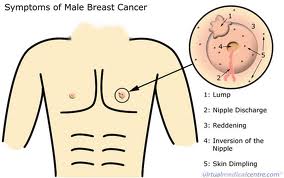Men are also able to at risk of breast cancer similar to women, but the rate is lower. Male breast cancer makes up less than 1 percent of all cases of breast cancer, and is usually detected in men between 60 and 70 years of age.
Symptoms
Even though men have less breast tissues than women, they do have breast cells that can undergo cancerous changes. Therefore, if noticing any of the following changes, you should go to to a doctor:
- A lump or swelling in the chest area
- Dimpled or puckered skin
- A nipple that is inverted (facing inward)
- Redness or scaling of the nipple or breast skin
- Discharge from the nipple
Most breast lumps in men are due to gynecomastia and not cancer. Gynecomastia, the most common male breast disorder, is an increase in the amount of a man’s breast tissue. However, it is still important to see a medical professional about any of the symptoms, including a lump, to rule out male breast cancer.
Types:
The following types of breast cancer are diagnosed in men:
- Infiltrating ductal carcinoma: Cancer that has spread beyond the cells lining ducts in the breast. As with women, most men with breast cancer have this type of cancer.
- Ductal carcinoma in situ: Abnormal cells that are found in the lining of a duct; also called intraductal carcinoma.
- Inflammatory breast cancer: A type of cancer in which the breast looks red and swollen and feels warm.
- Paget’s disease of the nipple: A tumor that has grown from ducts beneath the nipple onto the surface of the nipple.
Stages:
The stages of male breast cancer, and the prognosis at each stage, are the same as for female breast cancer. However, the Stage 0 – carcinoma in situ,(abnormal cells found in one of the lobes or sections of the breast), sometimes occurs in women, has not been seen in men.
There are four main stages of male breast cancer and a recurrent stage:
Stage I – Stage I is an early stage of invasive breast cancer. In Stage I, cancer cells have not spread beyond the breast and the tumor is no more than 2 centimeters (three-quarters of an inch) across.
Stage II – Stage II is one of the following:
- The tumor in the breast is no more than 2 centimeters (three-quarters of an inch) across. The cancer has spread to the lymph nodes under the arm.
- The tumor is between 2 and 5 centimeters (three-quarters of an inch to 2 inches). The cancer may have spread to the lymph nodes under the arm.
- The tumor is larger than 5 centimeters (2 inches). The cancer has not spread to the lymph nodes under the arm.
Stage III – Stage III may be a large tumor, but the cancer has not spread beyond the breast and nearby lymph nodes. It is locally advanced cancer.
- Stage IIIA – Stage IIIA is one of the following:
- The tumor in the breast is smaller than 5 centimeters (2 inches). The cancer has spread to underarm lymph nodes that are attached to each other or to other structures.
- The tumor is more than 5 centimeters across. The cancer has spread to the underarm lymph nodes.
- Stage IIIB – Stage IIIB is one of the following:
- The tumor has grown into the chest wall or the skin of the breast.
- The cancer has spread to lymph nodes behind the breastbone.
- Inflammatory breast cancer is a rare type of Stage IIIB breast cancer. The breast looks red and swollen because cancer cells block the lymph vessels in the skin of the breast.
- Stage IIIC – Stage IIIC is a tumor of any size. It has spread in one of the following ways:
- The cancer has spread to the lymph nodes behind the breastbone and under the arm.
- The cancer has spread to the lymph nodes under or above the collarbone.
Stage IV – Stage IV is distant metastatic cancer. The cancer has spread to other parts of the body.
Recurrent cancer – Recurrent cancer is cancer that has come back (recurred) after a period of time when it could not be detected. It may recur locally in the breast or chest wall as another primary cancer, or it may recur in any other part of the body, such as the bone, liver, or lungs, which is generally referred to as metastatic cancer.
Differences between male and female breast cancer:
Breast size: Men have less breast tissue than women, that does make it easier to feel small masses. For the same reason, though, cancers do not grow far before reaching the skin covering the breast or the muscles underneath. The result is that while male breast cancers tend to be smaller than female breast cancers when they are found, they have more often spread beyond the breast.
Rate: Another key difference is that breast cancer is rare among men. Most women are aware of breast cancer and have a female friend or family member affected by breast cancer. Men often do not even know it is possible for them to get breast cancer, and therefore may ignore the symptoms.
Treatment
Once detected with breast cancer at the early stage, men immediately should be treated with right therapies basing on the types of breast cancer, staging, and patterns of how the disease spreads. The treatment, of course, is similar to treatment for female.
A mastectomy, a surgical procedure to remove the breast with the cancerous tumor, is generally the treatment of choice for male breast cancer.
Chemotherapy, radiation and hormone therapies are also used following surgery.
